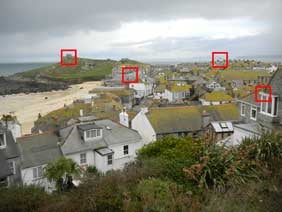Nikon COOLPIX S80
-
-
Written by Gordon Laing
Quality
Nikon COOLPIX S80 vs Sony Cyber-shot TX9 vs Panasonic Lumix FX700 Real-life resolution
Nikon COOLPIX S80 |
Sony Cyber-shot TX9 |
Panasonic Lumix FX700 | ||
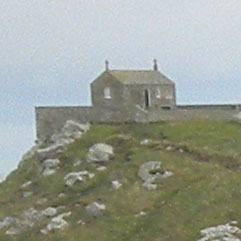 | 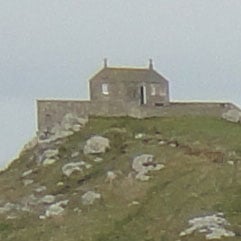 | 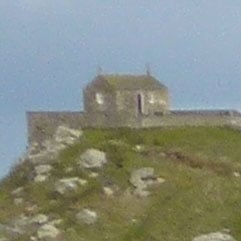 | ||
f3.6, 80 ISO |
f4.5, 125 ISO |
f4, 100 ISO | ||
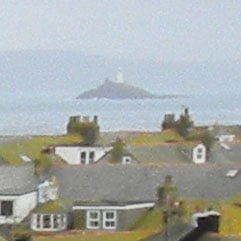 | 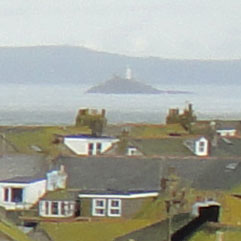 | 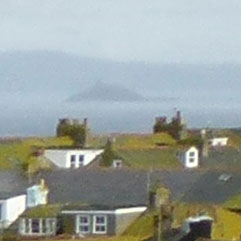 | ||
f3.6, 80 ISO |
f4.5, 125 ISO |
f4, 100 ISO | ||
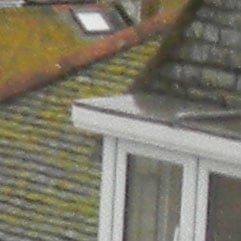 | 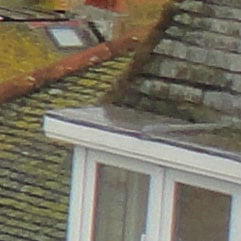 | 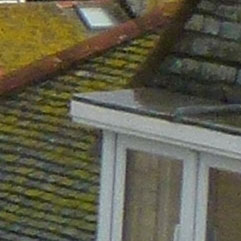 | ||
f3.6, 80 ISO |
f4.5, 125 ISO |
f4, 100 ISO | ||
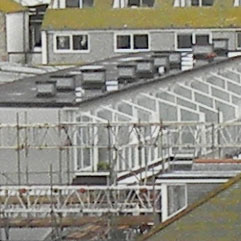 | 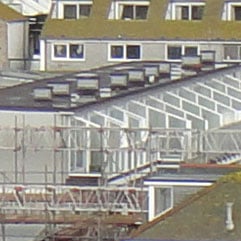 | 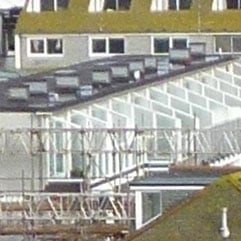 | ||
f3.6, 80 ISO |
f4.5, 125 ISO |
f4, 100 ISO |
The above image was taken with the Nikon COOLPIX S80 in Auto mode. The lens was set to its maximum wide angle setting of 6.3mm (35mm equivalent) and the metering selected an exposure of 1/264th of a second at f3.6 with the sensitivity at 80 ISO. The original 4320 x 3240 pixel image had a file size of 5.86MB. The crops are taken from the areas marked with red rectangles and are presented here at 100%. Our test scene usually poses something of an exposure challenge for compact sensors, but on this particular day with bright, but overcast weather conditions the scene lacks its usual wide dynamic range. The COOLPIX S80 hasn’t got the exposure quite right though and slight over-exposure has resulted in a blown highlight region in the sky. To be fair, the central area of the image, to which the metering is weighted is well exposed, but there’s a gap on the left side of the histogram that shows the COOLPIX could have given this scene about half a stop less exposure and gained some highlight detail in the sky without losing any from the shadows. The COOLPIX S80 crops all have a slightly granular quality to them. This is most apparent in the second lighthouse crop where the sky region, which you wouldn’t expect to see texture in, is quite grainy. The same can be said of the sea in the middle third of the crop and even the detail in the rooftops in the foreground look clumpy and irregular. The next crop down suffers from the same problem, but the graininess has been overtaken and slightly supressed because of the softness in this crop, taken from the edge of the frame. While the graininess is global, and no doubt due to sensor and processor limitations the softness, which is apparent to a greater degree at the frame edge, is a lens limitation. The best result from the COOLPIX S80 is the balcony crop taken from near the centre of the frame. This shows pretty good detail, though the contrast is a little harsh and there’s still that persistent graininess. By comparison, the crops from the Sony Cyber-shot TX9 look to be cleaner and more detailed than those from the COOLPIX S80. The Cyber-Shot TX9’s 12 Megapixel sensor seems capable of producing good image detail without the clumpiness and processed look of those from the COOLPIX S80. The Cyber-shot TX9 crops are also more consistent, with sharpness and detail maintained right to the frame edge, but there is a hint of fringing in the Cyber-shot TX9 edge crop – something the COOLPIX S80 manages to avoid, or at least correct for. The crops from the Panasonic Lumix FX700 don’t fare very well by comparison with either the COOLPIX S80 or the Sony Cyber-shot TX9. Like the COOLPIX S80, detail in the Lumix FX700 crops has a clumpy, granular consistency, only here it’s it’s much more noticeable. In fact, in places image detail has disappeared altogether – the crosses on the chapel roof in the first crop are very indistinct and the lighthouse in the second crop has disappeared altogether. On a more positive note, like the COOLPIX S80, the Lumix FX700 shows no evidence of colour fringing at the edges of the frame. Now let’s see how they compare at higher sensitivities in our High ISO Noise results. |
Nikon COOLPIX S80 vs Sony Cyber-shot TX9 vs Panasonic Lumix FX700 High ISO Noise
|
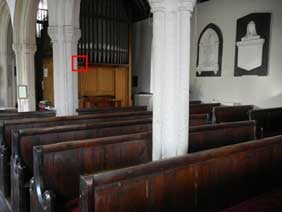 | To compare noise levels under real-life conditions we shot this scene with the Nikon COOLPIX S80, the Sony Cyber-shot TX9, and the Panasonic Lumix FX700 within a few moments of each other using their best quality JPEG settings at each of their ISO sensitivity settings. All three cameras were set to Program Auto exposure mode, the lenses were set to approximate the same field of view and ISO was manually set. |
The above shot was taken with the the Nikon COOLPIX S80 in Auto mode with the lens at its widest angle setting of 6.3mm (35mm equivalent). The sensitivity was set to 80 ISO and the exposure was 0.8 of a second at f3.6. The crops are taken from the area marked with the red square and presented below at 100%.
The Crops from the Nikon COOLPIX S80 in terms of noise are quite encouraging, though there are some other issues. Let’s start on a positive note though – the COOLPIX S80 was the only one of the three cameras in this comparison to reproduce good tonal detail in the shadow areas of the scene from which we take our crops. This isn’t an exposure issue, all three cameras set a very similar exposure, in fact the Lumix exposure was greater by almost a stop, yet neither the Lumix FX700 nor the Cyber-shot TX9 (both of which have CMOS sensors) have recorded much, if any, of the shadow detail.
The first crop from the COOLPIX S80, taken at 80 ISO shows good overall detail with no evidence of noise that we can see, though, in the wood panelling you can make out the same slight granularity that was in evidence in the outdoor crops. It’s often quite difficult to spot any difference between 80 and 100 ISO settings, but this isn’t the case here and the 100 ISO crop is softer with less detail , most noticeably in the stone column, than in the 80 ISO one. Given the small advantage that moving up to 100 ISO will provide, we’d recommend S80 owners to stick with the lowest 80 ISO setting whenever possible.
There’s a similar small quality degradation between 100 and 200 ISO, but all three lower ISO settings produce good results that you’d be hard pressed to tell apart unless you were comparing them at 100%. At 400 ISO, as you’d expect, there’s a further significant downward step, with a lot of the finer detail disappearing along with whatever noise has been supressed. Nonetheless, at the 400 ISO sensitivity, the COOLPIX S80 still produces highly usable images. At 80 ISO we’re well into high ISO noise territory, or at least the loss of detail and image break up that result with its aggressive suppression. The detail in these crops and those at the higher 1600, 3200 and 6400 settings is still holding together though, and isn’t as badly broken up as as some we’ve seen.
Alongside the crops from the Sony Cyber-shot TX9 the COOLPIX S80 crops look very good indeed. The fact that you can see much more of the shadow detail is a big plus and the COOLPIX S80 crops also hold more fine image detail than those from the Cyber-shot TX9. Both the 80 and 100 ISO options on the COOLPIX S80 are lower than the base 125 ISO setting on the Cyber-shot TX9 and the COOLPIX results at these ISO sensitivities look better than those from the TX9 at 125 ISO. Even the COOLPIX S80 400 ISO shot outshines the Cyber-shot TX9 at 200 ISO in which you can see the edge of the stone column begining to break up. All the way up the ISO range it’s the same story, with the COOLPIX S80 outperforming the Cyber-shot TX9 eventually reaching parts of the range – 6400 ISO at 3 Megapixel resolution – that are out of the reach of the Cyber-shot TX9. Don’t forget, though, the TX9 has a trick or two up its sleeve when it comes to low light performace with its Hand-held Twilight and Anti Motion blur modes.
Like the Cyber-shot TX9 the Lumix FX700 has failed to retain tonal detail in the shadows, despite selecting a very similar exposure to the the other two cameras. The Lumix FX700 results are also quite cold in terms of colour balance. Right from the off at 100 ISO the Lumix FX700 crops are lacking in detail and look very processed and for that reason we’d put the Lumix FZ700 in third place behind the Nikon COOLPIX S80 and sony Cyber-shot TX9.
Now head over to our Nikon COOLPIX S80 gallery to see some more real-life shots in a variety of conditions.
Nikon COOLPIX S80 |
Sony Cyber-shot TX9 |
Panasonic Lumix FX700 | ||
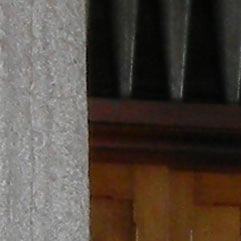 | ||||
80 ISO |
80 ISO Not available |
80 ISO Not available | ||
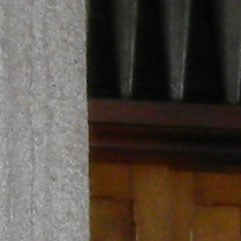 |  |  | ||
100 ISO |
125 ISO |
100 ISO | ||
 | 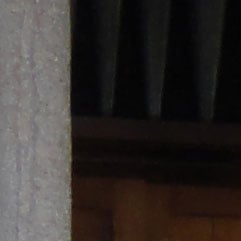 | 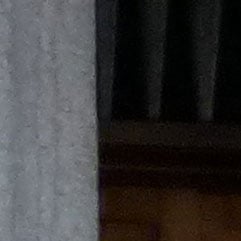 | ||
200 ISO |
200 ISO |
200 ISO | ||
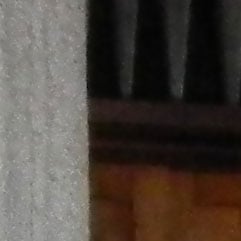 |  | 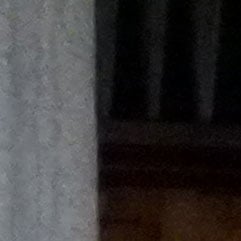 | ||
400 ISO |
400 ISO |
400 ISO | ||
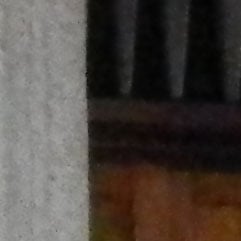 | 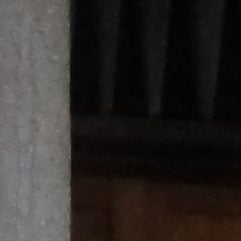 | 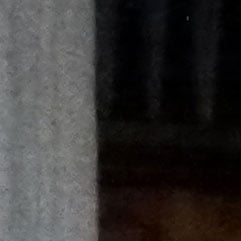 | ||
800 ISO |
800 ISO |
800 ISO | ||
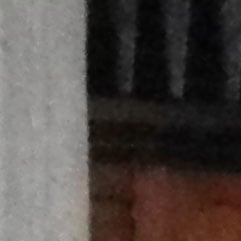 | 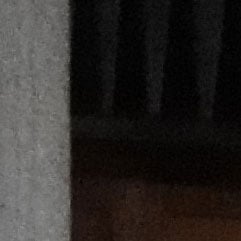 | 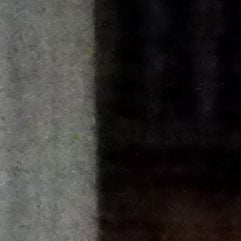 | ||
1600 ISO |
1600 ISO |
1600 ISO | ||
 | 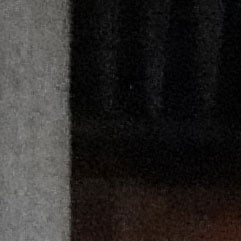 | 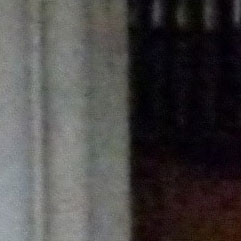 | ||
3200 ISO (3M) |
3200 ISO |
3200 ISO (High Sens scene mode) | ||
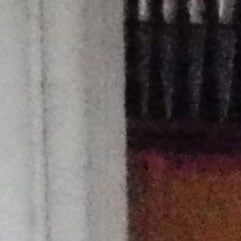 | ||||
6400 ISO (3M) |
6400 ISO Not available |
6400 ISO Not available |
